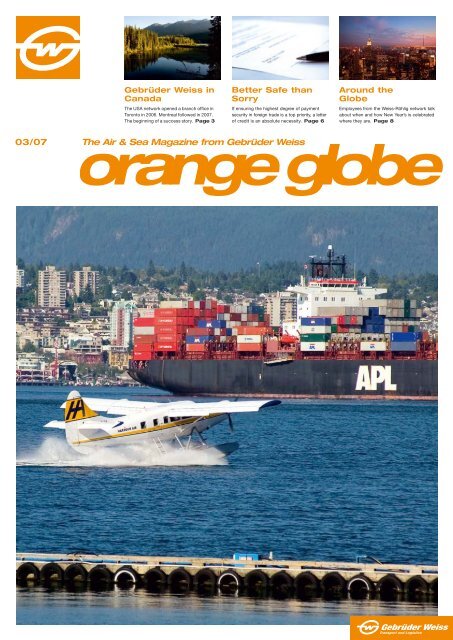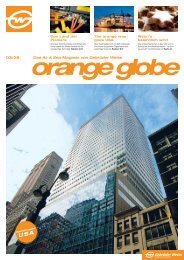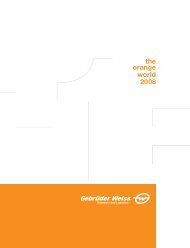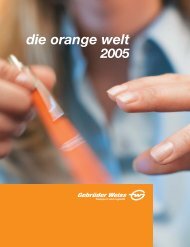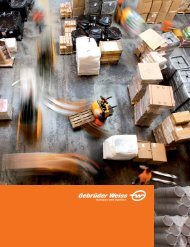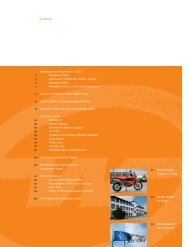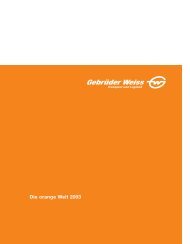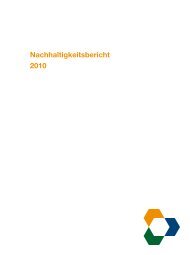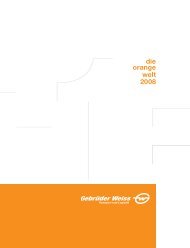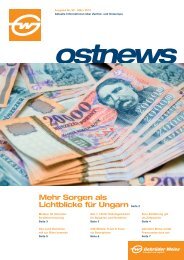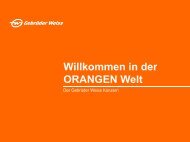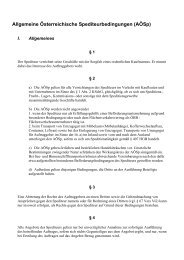The Air & Sea Magazine from Gebrüder Weiss 03/07
The Air & Sea Magazine from Gebrüder Weiss 03/07
The Air & Sea Magazine from Gebrüder Weiss 03/07
Create successful ePaper yourself
Turn your PDF publications into a flip-book with our unique Google optimized e-Paper software.
<strong>03</strong>/<strong>07</strong><br />
<strong>Gebrüder</strong> <strong>Weiss</strong> in<br />
Canada<br />
<strong>The</strong> USA network opened a branch office in<br />
Toronto in 2006. Montreal followed in 20<strong>07</strong>.<br />
<strong>The</strong> beginning of a success story. Page 3<br />
Better Safe than<br />
Sorry<br />
If ensuring the highest degree of payment<br />
security in foreign trade is a top priority, a letter<br />
of credit is an absolute necessity. Page 6<br />
<strong>The</strong> <strong>Air</strong> & <strong>Sea</strong> <strong>Magazine</strong> <strong>from</strong> <strong>Gebrüder</strong> <strong>Weiss</strong><br />
Around the<br />
Globe<br />
Employees <strong>from</strong> the <strong>Weiss</strong>-Röhlig network talk<br />
about when and how New Year’s is celebrated<br />
where they are. Page 8
orange globe – editorial<br />
Between 1948 and 2004 global<br />
trade increased by 27 times, while<br />
the production of goods only<br />
increased by about 8 times within<br />
the same period.<br />
Global commerce has been experiencing double-digit<br />
growth since China joined the WTO. Such rapid growth<br />
would not have been possible without having specific<br />
regulations in place that are valid beyond national borders.<br />
With the Incoterms, the International Chamber of<br />
Commerce created a benchmark for the international<br />
movement of goods. In addition to providing these terms,<br />
the organisation also helps to regulate and ensure<br />
con sistency in the processing of documentary credits,<br />
which act as a guarantor for maximum payment security<br />
in foreign trade. Read pages 6 and 7 to learn more about<br />
the types of obstacles that can present them selves in<br />
day-to-day business in connection with commercial terms<br />
and letters of credit. Find out how our staff can assist<br />
you in overcoming these or avoiding them all together.<br />
After the <strong>Weiss</strong>-Röhlig joint venture had success fully<br />
established itself on the US market, the time was right to<br />
cross the national border to the north. We have dedicated<br />
this edition of orange globe to Canada, the land of two<br />
million lakes.<br />
It all began two years ago with an office in Toronto. In the<br />
meantime, a second one has now been recently opened<br />
in Montreal. With the provinces of Ontario and Quebec<br />
producing nearly two thirds of Canada’s GDP, we have<br />
an excellent strategic position with a third branch in<br />
Vancouver to follow in the medium term.<br />
I am convinced that Canada will play an increasingly<br />
important role within <strong>Weiss</strong>-Röhlig’s global network. And<br />
not just in international transport, but more and more as a<br />
skilled pro-vider of tailor-made logistics solutions as well.<br />
Neither Christmas nor New Year’s is celebrated the<br />
same way in all cultures. However, as the year comes to<br />
a close, I would like to use the coming holidays as an<br />
opportunity to thank you, on behalf of all of our <strong>Air</strong> & <strong>Sea</strong><br />
staff around the globe, for the trust you have given us<br />
throughout the year. I wish you peaceful holidays and a<br />
happy and successful New Year 2008!<br />
Heinz Senger-<strong>Weiss</strong>,<br />
<strong>Air</strong> & <strong>Sea</strong> Management Board<br />
GW-<strong>Air</strong> GW <strong>Air</strong> & <strong>Sea</strong>–Contact<br />
<strong>Sea</strong>–Kontakt<br />
<strong>Gebrüder</strong> <strong>Weiss</strong> GmbH<br />
Bundesstraße 110, A-6923 Lauterach<br />
T +43.5574.696.2<strong>07</strong><br />
F +43.5574.70928<br />
air-sea@gw-world.com<br />
www.gw-world.com<br />
orange globe<br />
forwarding abc’s<br />
Country-specific surcharges<br />
AMS Fee/ACI Fee This fee is generally imposed<br />
for goods export into the USA, Canada and Mexico; it is also applied to airfreight<br />
traffic to India. By means of the AMS (automated manifest system) or ACI (advance<br />
customs information), shipment information is sent in advance electronically to the<br />
customs authorities in the respective country.<br />
Heavy Weight Surcharge If cargo volumes<br />
in certain regions or countries are exceptionally high (as is currently the case in China),<br />
shipping companies will pay closer attention to the weight of containers. A weightdependent<br />
surcharge is imposed for heavy loads, which considerably limit the<br />
number of containers ships can carry.<br />
Peak <strong>Sea</strong>son Surcharge<br />
Shipping companies impose a surcharge in certain regions when the load volume<br />
increases due to seasonal peaks.<br />
War Risk Surcharge This risk surcharge is applied<br />
to sea freight shipments into war zones or countries with war-like conditions.<br />
A Critical View<br />
Radically Changing Industry<br />
Michael Büchele, Regional<br />
Management Central, talks<br />
about administrative and<br />
operational expenditures that<br />
require increasing amounts of<br />
resources and foresees greater<br />
challenges in the future.<br />
Load – transport – unload. Transporting goods hasn’t<br />
been that simple for a long time. <strong>The</strong> customer’s requirements<br />
are becoming more and more complex. Total<br />
logistics solutions are in demand. At the same time, the<br />
prevailing conditions in freight traffic are subject to<br />
constant, and at times, sweeping change. Tougher laws,<br />
tightened regulations and new statutes bring about<br />
greater organisational expenditure. <strong>The</strong> term “security”<br />
has been given a whole new meaning for air traffic in<br />
particular. Rigorous security regulations were introduced<br />
in the aftermath of September 11. Under these provisions,<br />
“regulated agents” such as <strong>Gebrüder</strong> <strong>Weiss</strong> became<br />
obligated to adhere to a number of measures affecting<br />
both operative and administrative aspects of airfreight<br />
handling. Among these was the naming of security agents<br />
and the training of employees in the new regulations.<br />
Increased safety standards had to be applied in warehouse<br />
facilities in order to rule out any possible manipu-<br />
lation. Declarations must be obtained <strong>from</strong> customers so<br />
as to declare them as “known shippers”.<br />
Meanwhile, the surcharge jungle in sea freight is<br />
growing even thicker. From the new low sulphur surcharge<br />
based on the amount of sulphur in a ship’s fuel, to the<br />
peak season, congestion, demurrage and heavy weight<br />
surcharges often applied to shipments to and <strong>from</strong> China<br />
– and these are just a few of the surcharges imposed by<br />
shipping companies.<br />
Part of our responsibility is also having up-to-date information<br />
on country-specific regulations. For example, the<br />
maximum allowable weight for containers transported on<br />
the road varies <strong>from</strong> country to country. Likewise, import<br />
regulations for wood packaging vary throughout the world.<br />
What’s more, they are constantly changing. And,<br />
especially with regard to ecology and safety, we will<br />
be facing even greater challenges in the future.
orange globe – topic<br />
What was once a United States network has now<br />
become a North American alliance. <strong>The</strong> joint venture<br />
has established two Canadian offices, with one in<br />
Toronto and the other in Montreal. Incorporated into<br />
the international <strong>Weiss</strong>-Röhlig Organisation, <strong>Weiss</strong>-<br />
Röhlig Canada has established itself in the local<br />
Canadian market as a dependable and experienced<br />
partner for the movement of goods worldwide.<br />
As neighbouring countries, Canada and the United<br />
States are connected by both common border and<br />
especially the language and culture they share. “<strong>The</strong><br />
markets are very similar and have been dependent on<br />
each other for a long time now,” says Arnaud Majstorovic,<br />
Executive Vice-President of <strong>Weiss</strong>-Rohlig Canada Inc.<br />
For Maj sto ro vic, <strong>Weiss</strong>-Röhlig’s expansion to Canada was<br />
a logical next step.<br />
Rapid Growth<br />
In the summer of 2006, the joint venture finally began<br />
the Canadian adventure with its own staff in Toronto, the<br />
capital of Ontario. From the start, the company’s strong<br />
background proved very valuable. “It wasn’t as if we were<br />
standing there empty handed as we founded the<br />
com pany; <strong>Gebrüder</strong> <strong>Weiss</strong> and Röhlig had already been<br />
active in Canada in the past through agents,” Arnaud<br />
Majstorovic adds. European transport and logistics organisations<br />
were already known on the market and had a good<br />
reputation. “<strong>The</strong> company’s image surely played a role<br />
in our ability to build trusting business alliances with<br />
customers as well as regional contractual partners.”<br />
A second branch followed only one year later in<br />
Montreal. Canada’s second-largest city after Toronto is<br />
both an important business location and destination<br />
within the GW Group. In Arnaud Majstorovic’s opinion,<br />
being located in this metropolis in the French-influenced<br />
It was five years ago that <strong>Gebrüder</strong> <strong>Weiss</strong> dared<br />
to cross the big pond together with joint venture<br />
partner Röhlig to begin establishing a network of<br />
locations in the United States. In no time, <strong>Weiss</strong>-<br />
Röhlig North America turned into a success story<br />
that continued with the expansion to Canada.<br />
<strong>The</strong> North American<br />
Connection<br />
<strong>The</strong> beginning of a success story<br />
„<br />
Other possible locations<br />
would be Vancouver, for<br />
example, for the Pacific trade<br />
and Calgary for oil, gas and<br />
project contracts.<br />
province of Quebec has clear advantages: “We are able to<br />
take care of distribution and customer service in the<br />
best possible way using our own team. This enables us<br />
to better fulfil the requirements of existing regional<br />
customers on the one hand, and acquire new customers<br />
more quickly on the other. We are almost guaranteed<br />
to ex perience rapid growth in the regional market.”<br />
A <strong>Sea</strong>mless Transport Chain<br />
For the Executive Vice-President, there is no question<br />
as to why <strong>Weiss</strong>-Röhlig Canada is better than the competition:<br />
“Our employees make the difference. <strong>The</strong>y are<br />
highly skilled, anticipate customer needs and are always<br />
avail able.” On top of that, they are extremely flexible,<br />
“which allows us to offer logistics solutions that meet<br />
even the highest demands.” Here, <strong>Weiss</strong>-Röhlig’s international<br />
network plays an important role. Even with the<br />
small size of the company when considering Canada’s<br />
sheer vastness, nearly all business that has to do with the<br />
international movement of goods can be carried out<br />
through this network. “And we can also count on the local<br />
expertise of our overseas partners,” Arnaud Majstorovic<br />
adds, “which results in a seamless transport chain <strong>from</strong><br />
the consignor to the consignee and guarantees that the<br />
forwarding process is carried out smoothly.” In addition to<br />
international air and sea freight, <strong>Weiss</strong>-Röhlig Canada’s<br />
service portfolio also includes project shipments. Subcontractors<br />
are hired to handle customs clearance, warehouse<br />
logistics and distribution. More than 70 percent<br />
of finished goods importing and exporting takes place<br />
in the provinces of Quebec and Ontario; the activities<br />
are concentrated for the most part over a 700 kilometre<br />
long line between Quebec City, Quebec, and Hamilton,<br />
Ontario. “We cover this area completely with our offices<br />
in Montreal and Toronto, which means we already have<br />
a foothold in a very large market,” says the Executive Vice-<br />
President. Strategic expansion of the network is already<br />
being planned: “Other possible locations would be<br />
Vancouver, for example, for the Pacific trade and Calgary<br />
for oil, gas and project contracts.”<br />
A Promising Future<br />
“Currently around two thirds of our business activities<br />
are focused on the importation of goods, with air and sea<br />
freight accounting for equal shares of this business.<br />
Exports account for one third of our business,” reports<br />
Arnaud Majstorovic. By far, the largest market is Europe<br />
(with a 72% share), followed by Oceania (with a solid 17%<br />
share), Africa (7%) and Southeast Asia (4%).<br />
And the statistics show that Canada is importing more<br />
and more finished goods every year: <strong>Sea</strong>ports and<br />
air ports regularly report record numbers; airlines and<br />
shipping companies are increasing their capacities and<br />
starting to offer new destinations. “<strong>The</strong>se are all signs<br />
that point to a promising future for the transport and<br />
logistics industry in Canada,” Arnaud Majstorovic states<br />
enthusiastically. <strong>The</strong> Manager sees <strong>Weiss</strong>-Röhlig Canada’s<br />
greatest potential for growth once again in China: “<strong>The</strong><br />
countries of Southeast Asia, the People’s Republic in<br />
particular, are without a doubt the world’s leading producing<br />
countries. And they will continue to hold this<br />
position in the coming years as well.”<br />
Personal Profile<br />
Arnaud Majstorovic<br />
Executive Vice-President of<br />
<strong>Weiss</strong>-Rohlig Canada Inc.<br />
Age:<br />
36 years<br />
Nationality:<br />
French<br />
Residence:<br />
Toronto<br />
He appreciates:<br />
Discussions,<br />
sunny days,<br />
honest people<br />
He doesn’t like:<br />
People with<br />
a bad attitude,<br />
his Blackberry<br />
Food & Drink:<br />
Mexican food<br />
(especially fajitas),<br />
water<br />
Hobbies:<br />
Cars, painting, travelling<br />
with his family<br />
Motto:<br />
“If it ain’t broken,<br />
don’t fix it!”<br />
Goals:<br />
To further establish<br />
<strong>Weiss</strong>-Röhlig Canada<br />
and learn something<br />
new every day in the<br />
process
orange globe – focus<br />
Fact Box<br />
Canada<br />
Permafrost and granaries, the Rocky Mountains and endless expanses,<br />
modern cities and remote outposts, national pride and separatist tendencies<br />
– Canada is full of contrasts. <strong>The</strong> world’s second-largest country has a<br />
fascinating way of combining local colour and cosmopolitanism and is much<br />
more than just the “little brother” of the United States.<br />
Land<br />
In the<br />
of the<br />
Maple<br />
Area: 9,984,670 km²<br />
Population: 32.98 million<br />
Population density: 3.3/km²<br />
Capital city: Ottawa<br />
Official languages: English, French<br />
Form of government: Parliamentary<br />
democracy (federal<br />
constitutional monarchy)<br />
belonging to the British<br />
Commonwealth<br />
Provinces: 10<br />
Territories: Northwest<br />
Territories, Nunavut,<br />
Yukon Territory<br />
Gross domestic product:<br />
1.130 trillion USD (2006)<br />
Economic growth: 2.9 % (2005)<br />
Unemployment rate: 5.9 % (20<strong>07</strong>)<br />
Currency: Canadian dollar<br />
1 Canadian dollar (C$) = 100 cents<br />
(1 CAD ~ 1.<strong>03</strong> USD)<br />
Leaf<br />
<strong>The</strong> Hudson’s Bay Company is Canada’s oldest<br />
commercial corporation and, at the same time,<br />
one of the oldest companies in the world. With its<br />
origins in the fur trade, to some extent, the HBC<br />
represents the development of the country <strong>from</strong> a<br />
remote colonial region into a modern cosmopolitan<br />
and economic centre with dynamic cities. Yet what<br />
makes Canada so unique is its natural beauty and<br />
resources: the thundering Niagara Falls, the rugged<br />
Rocky Mountains and the outdoor paradise of<br />
Vancouver Island.<br />
Jacques Cartier was hired by the king of France to find<br />
a sea route to the Orient that should be free of perils and<br />
as short as possible. An Italian had already attempted this<br />
in 1492, sailing under the Spanish flag, yet was un -<br />
successful; Christopher Columbus never made it further<br />
than America. <strong>The</strong> American continent stood in the way of<br />
Cartier as well, but he landed considerably higher north<br />
than Columbus. It is likely that the Viking Leif Eriksson had<br />
taken a similar route 500 years before him. Viking settlements<br />
were discovered on Newfoundland dating back to<br />
a period more than 1,000 years ago – contrary to the<br />
long-standing opinion that John Cabot had discovered<br />
Canada.<br />
<strong>The</strong> Indian Village<br />
A helpful Iroquois showed Jacques Cartier the way to<br />
“Canada” – the Indian name for village. As was customary<br />
of that time, Cartier immediately seized the area of land for<br />
his king and, “instead of fulfilling what he was actually hired<br />
to do, he spent most of his time trying to convince the<br />
natives that they were now illegal inhabitants on the land of<br />
a country that belonged to ruler whose kingdom was three<br />
thousand miles away,” remarks university professor John<br />
Munro. All the same, Jacques Cartier gave the second<br />
largest country in the world its name. And he also discovered<br />
the Saint Lawrence River. <strong>The</strong> French eventually<br />
founded Quebec at the beginning of the 16th century.<br />
<strong>The</strong> North American continent would later become the<br />
battleground for conflicts that had been going on between<br />
France and England for centuries. After the Seven Years’<br />
War France was forced to cede all of its Canadian colonial<br />
possessions to England.<br />
Canada’s movement towards independence came in<br />
steps: <strong>The</strong> first one was taken with the British North<br />
America Act, which more or less became the Canadian<br />
constitution. Yet the country did not become completely<br />
sovereign until 1982.<br />
Two Million Lakes<br />
This giant country with two million lakes is divided into<br />
ten provinces and three territories. <strong>The</strong> population density<br />
is three inhabitants per square meter; in comparison,<br />
Germany has 231. Although Canada is nearly as large as<br />
all of Europe, it has fewer inhabitants than Poland.<br />
It is covered with forests that stretch over vast expanses<br />
as well as large areas of tundra. Almost 90 percent of the<br />
Canadian population lives along the border to the United<br />
States. Vancouver is considered to be “the most beautiful<br />
city in Canada”. Montreal and Quebec have a very European<br />
flair, with a noticeably French influence. This is no surprise,<br />
as Montreal is the second largest French speaking<br />
city in the world and Quebec is the only Canadian province<br />
whose official language is French. Toronto, the economic<br />
centre of the country, is hardly distinguishable in its<br />
appearance <strong>from</strong> any other typical American city.<br />
<strong>The</strong> Native Americans, French and English have created<br />
an exciting mix of traditions that still influences Canadian<br />
art and culture today. Canada is the birthplace of countless<br />
artists such as the singers Neil Young, Leonhard Cohen<br />
and Joni Mitchell, the actors Keanu Reeves and Jim Carrey<br />
as well as the pianist Glenn Gould to name just a few. <strong>The</strong><br />
most outstandingly unique art is considered to be that of<br />
the Inuit, especially their sculptures and carvings.<br />
Bizarre Politicians<br />
As is typical of many immigrant countries, the population<br />
is very heterogeneous. “If you were to ask ten Canadians<br />
what a typical Canadian is like, you’d probably get ten<br />
different answers,” John Munro writes in his book “<strong>The</strong><br />
splendour of Canada”. This sheds light on the fact that<br />
Canada has had a number of bizarre politicians over the<br />
course of its history, which, in some cases, have had a
major influence on the country. Prime Minister William<br />
Lyon Mackenzie-King trusted his mother’s advice above<br />
all else when making important decisions. This alone is<br />
not all that unusual, if you ignore the fact that she had<br />
already been dead for many years and that he received<br />
these messages <strong>from</strong> the beyond through his terrier.<br />
Even with all of these quirks, he was still able to remain<br />
in office for a total of 21 years.<br />
Prime Minister Pierre Trudeau, who governed with<br />
breaks <strong>from</strong> 1968 to 1984, officially established bilingualism<br />
in Canada. Trudeau was also the first head of government<br />
who was willing to meet with John Lennon and Yoko<br />
Ono on their “Tour for World Peace”. After having met with<br />
the Prime Minister, Lennon said: “If all politicians were like<br />
Pierre Trudeau, there would be peace in the world.” Under<br />
the leadership of Trudeau, Canada was the first Western<br />
country to begin diplomatic relations with the People’s<br />
Republic of China – much to the annoyance of the US<br />
President at that time, Richard Nixon.<br />
<strong>The</strong> fact that Canada is a liberal country is reflected<br />
in the “Freedom of Information Act”: Every citizen can<br />
petition the government for official documents. <strong>The</strong> only<br />
exceptions are cases in which national security could<br />
be jeopardised.<br />
<strong>The</strong> country is not completely free of tensions, however.<br />
<strong>The</strong> relationship between Quebec and the English<br />
provinces is particularly problematic. Canada nearly split<br />
apart in 1995. Just a few thousand more votes and the<br />
separatists would have succeeded.<br />
„<br />
If you were to ask ten<br />
Canadians what a typical<br />
Canadian is like,<br />
you’d probably get<br />
ten different answers.<br />
— John Munro<br />
<strong>from</strong> his book “<strong>The</strong> splendour of Canada”<br />
Economic Superpower<br />
Canada is a member of the G8 and enjoys a level of<br />
economic growth most other nations can only dream of.<br />
For the last 15 years (!), the economy has been growing<br />
steadily; since 1995 it has been expanding at an average<br />
annual rate of 3.9 percent. Ontario and Quebec are the<br />
economic centres. More than 60 percent of the gross<br />
domestic product is generated in these two provinces. <strong>The</strong><br />
major businesses and industries including 85 percent of<br />
the workers are concentrated over a 350 kilometre wide<br />
strip along the border to the United States. In world trade<br />
statistics, Canada is ranked number nine for exports and<br />
ten for imports. <strong>The</strong> Canadian economy is closely linked to<br />
the US economy: <strong>The</strong> majority of Canada’s exports are to<br />
the USA, and more than half of all imports come <strong>from</strong> the<br />
neighbour to the south. Goods with a total weight of<br />
40 million tons are shipped every year on the St. Lawrence<br />
River between the Great Lakes and the Atlantic.<br />
Although Canada is rich in natural resources, the service<br />
sector now accounts for more than two thirds of the GDP,<br />
while the manufacturing industries now account for just<br />
under 20 percent. Other important economic sectors in -<br />
clude agriculture, minerals and natural gas.<br />
Yet there is a price to pay for the strong industrial orientation.<br />
Like the USA, Canada has not exactly won any<br />
international praise for its handling of environmental issues<br />
in the past. It is one of the world’s largest producers of CO 2<br />
and, on the whole, among the industrial countries with the<br />
worst record for environmental protection.<br />
World Champions<br />
On the other hand, Canadians are true lovers of nature.<br />
And there are plenty of natural wonders in Canada. Every<br />
year, for example, countless numbers of polar bears wait<br />
for the Hudson Bay to freeze so they can begin their hunt<br />
for seals. Churchill, Manitoba becomes the polar bear<br />
capital of the world every October and November.<br />
And Canadians love sports too. Besides lacrosse<br />
(a mixture of hockey and handball), the national sport is of<br />
course ice hockey, which was created in Canada in the<br />
19th century. <strong>The</strong> “Maple Leafs” hold the record for winning<br />
the most World Championships, even though they are<br />
almost never able to compete at full strength because<br />
of the National Hockey League (NHL) play-offs, which<br />
typically take place during the same time.<br />
Canada has hosted the Olympics twice already. <strong>The</strong><br />
Summer Games, which took place in Montreal in 1976,<br />
would prove to be a financial disaster. <strong>The</strong> city was<br />
burdened with debt for many years. <strong>The</strong> Montreal Olympic<br />
Games are still considered to have been the most<br />
expensive ever organised. But this didn’t stop Calgary<br />
<strong>from</strong> trying it again in 1988. And in 2010, Canada will<br />
host the Winter Games for the second time. This time they<br />
will take place in Vancouver and Whistler.<br />
Fact Box<br />
Ranked: 1<br />
Canada is the world’s<br />
largest paper producer<br />
and most important<br />
uranium supplier. <strong>The</strong> province of Quebec is<br />
the world’s largest producer of maple syrup, which<br />
is made <strong>from</strong> the sap of the sugar maple tree. <strong>The</strong><br />
leaf of this tree adorns the Canadian flag.<br />
Ranked: 2 Canada is second only to<br />
Russia in size and has the world’s second largest<br />
oil reserves after Saudi Arabia.<br />
Ranked: 3 Canada is ranked third in the<br />
statistics when it comes to gas or diamond production.
orange globe –<br />
interview<br />
Cash is what’s<br />
really behind a<br />
letter of credit<br />
An interview with Ingrid Scheffknecht,<br />
<strong>Sea</strong>freight Customer Service and<br />
Project Shipments<br />
Twelve years have passed since Ingrid<br />
Scheffknecht ended up in <strong>Sea</strong> Freight<br />
after coming <strong>from</strong> <strong>Air</strong>freight via Surface<br />
Traffic. Since then, the work in this area<br />
has always fascinated her. <strong>The</strong> 44 year<br />
old is also able to apply her extensive<br />
experience when a secure handling of<br />
payments is required in exporting goods.<br />
A letter of credit has been opened. What else do<br />
you need to pay particular attention to after that?<br />
You must make sure that the transport service provider<br />
is brought into the picture right away. I often find that<br />
companies are too careless when it comes to forwarding<br />
the letters of credit. <strong>The</strong>y book a regular container <strong>from</strong> us,<br />
it’s loaded, and suddenly a letter of credit comes into play<br />
once it’s time to put the transport documents together.<br />
But if the letter of credit happens to contain terms regarding<br />
the organisation of transport that can no longer be<br />
met at this point, substantial problems can be the result.<br />
One of the consequences can be that the container must<br />
be completely emptied and rebooked with another shipping<br />
company. <strong>The</strong> consignor pays for these costs.<br />
In your experience, what is usually the problem<br />
when difficulties arise in connection with letters<br />
of credit?<br />
It’s usually something little that makes the paperwork<br />
incorrect. It can be a note in a certificate, which the shipping<br />
companies aren’t allowed to formulate in such a way,<br />
or a clause that must be included in the bill of lading. For<br />
example: In the Indian state of Maharashtra it is a legal<br />
requirement that the transport document must have a<br />
specific formulation to regulate certain duties. Now, if it is<br />
expressly noted in the letter of credit that no additional<br />
costs may appear on the bill of lading, the forwarder is<br />
stuck between a rock and a hard place: <strong>The</strong> passage must<br />
be listed in the transport document. But that wouldn’t<br />
actually be allowed in this case.<br />
What consequences can the consignor expect in<br />
cases like this where there are discrepancies?<br />
<strong>The</strong> bank pays “under reserve”. <strong>The</strong> consignor usually<br />
gets his money; however, this occurs completely on the<br />
good will of the consignee. <strong>The</strong> letter of credit typically<br />
loses the absolute security it was intended to offer be -<br />
cause of this.<br />
What do you recommend to customers to<br />
guarantee that everything goes smoothly?<br />
<strong>The</strong>y shouldn’t let the consignee pressure them into<br />
including formulations that don’t make any sense, like<br />
“Goods may not be transported using a sailing vessel”.<br />
I also warn about terms that restrict the transport process<br />
too much. For example, assigning the shipment to a<br />
special shipping company can become expensive if there<br />
are no containers of that type available at the departure<br />
terminal. In any case, I strongly recommend the customer<br />
to provide us with a copy of the letter of credit in advance.<br />
We can work with the shipping company to go over the<br />
terms in detail, which can often remove obstacles right<br />
away – and save money in the end. Amending a letter of<br />
credit at a later time is extra work that the opening bank<br />
charges for, if there is even still time to do that.<br />
orange globe –<br />
reports<br />
Better Safe<br />
than Sorry<br />
If ensuring the highest degree of payment security in<br />
foreign trade is a top priority, a letter of credit is an<br />
absolute necessity. Even though there is a lot at<br />
stake, the beneficiaries are often much too careless:<br />
Approximately half of all submitted documents are<br />
incorrect.<br />
A letter of credit (L/C) is a payment promise <strong>from</strong> a bank<br />
separate <strong>from</strong> the underlying transaction. It has proven to<br />
be a suitable instrument to eliminate (many) risks in international<br />
business.<br />
If the contractual partners agree to a documentary letter<br />
of credit as a payment instrument, the purchaser will then<br />
contact a bank to open up one for the benefit of the seller.<br />
Once the seller has this documentary letter of credit in his<br />
possession, he can be assured that he will receive the<br />
agreed credit amount upon successful delivery of the<br />
goods. On the other hand, the purchaser has the assurance<br />
that he must only pay if the documents conform to the<br />
letter of credit and are presented within the agreed period.<br />
Documentary letter of credits can be subdivided into<br />
export and import letters of credit: With an export letter of<br />
credit, the exporter has a claim to payment for the exported<br />
goods. <strong>The</strong> purchaser must therefore open the letter of<br />
credit. With an import letter of credit on the other hand, a<br />
company receives goods <strong>from</strong> a foreign producer and<br />
must therefore take care of opening an import letter of<br />
credit itself.<br />
„<br />
If we are to set up an<br />
irrevocable letter of credit<br />
<strong>from</strong> this end for a “difficult”<br />
country, we contract a<br />
correspondent bank with<br />
a reputation in that country.<br />
— Austrian Bank for Tyrol and Vorarlberg<br />
<strong>The</strong>re are global regulations for the handling of business<br />
dealings backed by letters of credit. <strong>The</strong>se are outlined<br />
in the “Uniform Customs and Practice for Documentary<br />
Credits” (UCP) published by the International Chamber of<br />
Commerce in Paris. <strong>The</strong> most current version is “UCP600”,<br />
which came into effect in July 20<strong>07</strong>. It is binding for all<br />
parties.<br />
<strong>The</strong>re are only a small number of “risk countries” with<br />
regard to business dealings covered by letters of credit.<br />
Unstable countries marked by political turmoil and currency<br />
problems are considered economically problematic on<br />
the whole. <strong>The</strong> so-called country risk is generally assumed<br />
by banks only in the case of a confirmed letter of credit. “If<br />
we are to set up an irrevocable letter of credit <strong>from</strong> this end<br />
for a “difficult” country, we contract a correspondent bank<br />
with a reputation in that country,” according to the Austrian<br />
Bank for Tyrol and Vorarlberg.<br />
According to the credit institute, the essential element<br />
of a completely smooth process is to have documents that<br />
conform to the letter of credit: “It begins with agreeing on<br />
conditions that can actually be met, and ends with the<br />
beneficiary adhering to these.” In spite of knowing better,<br />
it appears that many beneficiaries don’t seem to take this<br />
issue seriously enough: “More than half of the submitted<br />
documents contain formal or factual errors.” Numerous<br />
discussions, intervention attempts and a corresponding<br />
financial burden is often the consequence. More over,<br />
documents with errors also give the consignee an easy<br />
target for attack – the only one in the otherwise secure<br />
environment provided by a letter of credit.<br />
Types of documentary letter of credits<br />
An irrevocable letter of credit can be neither<br />
amended nor annulled without the ap-proval of<br />
the opening bank, the beneficiary and eventually<br />
the confirming bank.<br />
With a confirmed letter of credit, the advising<br />
bank assumes an independent pay-ment obligation<br />
with its confirmation in addition to the opening<br />
bank’s obligation.<br />
With an unconfirmed letter of credit, the advising<br />
bank (credit office) only carries out the<br />
instructions <strong>from</strong> the opening bank. <strong>The</strong> bank is<br />
not considered a participant and is not liable for<br />
the payment.<br />
Some special types of<br />
letters of credit<br />
A transferable letter of credit enables the primary<br />
beneficiary (exporter, broker) to make his claims<br />
<strong>from</strong> the letter of credit available in whole or part<br />
to one or more secondary beneficiaries (the actual<br />
supplier).<br />
A red clause or green clause letter of credit<br />
contains clauses in the documentary letter of<br />
credit that entitle the exporter to an advance payment<br />
to finance advanced charges <strong>from</strong> the commercial<br />
transaction.<br />
A back-to-back letter of credit is an instrument<br />
used to finance intermediate trade. <strong>The</strong> beneficiary<br />
exporter <strong>from</strong> the original letter of credit<br />
contracts his bank to open a back-to-back letter<br />
of credit for the benefit of the vendor.<br />
A standby letter of credit (standby L/C) is a<br />
common hedging instrument used internationally<br />
that was originally created by banks in the USA.<br />
A standby L/C combines features of a bank<br />
guarantee and a letter of credit and is now used<br />
throughout the world.
A Milestone for<br />
World Trade<br />
<strong>The</strong> history of trade can be traced back at least<br />
140,000 years. At that time, long-distance trade<br />
relations already existed in Africa, the cradle of<br />
civilisation, with some trade activity stretching<br />
over several hundred kilometres. For the first time,<br />
a set of regulations for the international movement<br />
of goods, which were to be valid across the globe,<br />
were drafted by the International Chamber of<br />
Commerce (ICC) in 1936.With the Incoterms,<br />
the ICC created a benchmark.<br />
Completely different trade customs had developed<br />
throughout the world over the course of history. Misunderstandings<br />
and disputes between importers and exports<br />
were the result. <strong>The</strong> creation of the Incoterms (International<br />
Commercial Terms) made many of these differ-ences<br />
of opinion a thing of the past.<br />
“<strong>The</strong> Incoterms regulate the transfer of cost and risk as<br />
well as some of the obligations of the purchaser and seller<br />
resulting <strong>from</strong> the purchase contract,” says Klemens<br />
Strohmer, Product Manager <strong>Sea</strong>freight Central Eastern<br />
Europe. <strong>The</strong> commercial terms, however, do not at all<br />
replace the purchase contract. “This is because they don’t<br />
contain any information about the transfer of ownership or<br />
the terms of payment.”<br />
<strong>The</strong> terms have been revised periodically since they<br />
were first published. <strong>The</strong> currently valid version of the<br />
“Incoterms 2000” takes into account in greater depth the<br />
growing number of duty-free zones, electronic data interchange<br />
and the changing state of transport systems.<br />
Klemens Strohmer recommends that contractual partners<br />
make sure to agree on the current version of the<br />
“Incoterms 2000” and to specifically note this in the<br />
purchase contract.<br />
Problems start to arise when the Incoterms are misunderstood.<br />
<strong>The</strong> terms “ex works” (EXW) and “free carrier”<br />
(FCA) cause the most confusion. “EXW is often incorrectly<br />
used to define that the purchaser assumes the costs and<br />
risks for the entire transport starting <strong>from</strong> the seller’s warehouse,”<br />
says Klemens Strohmer. But that would be for-<br />
Info Box<br />
<strong>The</strong> Incoterms comprise 13 terms<br />
that are subdivided into four groups:<br />
Group E (Departure): <strong>The</strong> seller makes the goods<br />
available at his own premises. <strong>The</strong> transport costs<br />
and risks are borne by the purchaser.<br />
Group F: <strong>The</strong> seller hands the goods to a carrier<br />
named by the purchaser. <strong>The</strong> main transport costs<br />
and risks must be borne by the purchaser.<br />
Group C: <strong>The</strong> seller concludes the transport<br />
contract and assumes the transport costs, but not<br />
getting that the costs and risks for loading and cargo shift<br />
protection are assumed by the purchaser for EXW as well.<br />
If EXW has been agreed to, the seller is only obligated to<br />
make the goods available at his premises.<br />
And FCA does not mean that the seller must deliver<br />
the goods to a shipping terminal. Here you have to<br />
differentiate: If the named place is on the seller’s premises,<br />
the delivery is completed once the goods have been<br />
loaded onto the means of transport provided by the<br />
carrier that has been designated by the purchaser. If the<br />
named place is somewhere else, the delivery is completed<br />
once the goods have been made available to the carrier or<br />
a third party, unloaded, on the seller’s means of transport.<br />
Finally, Klemens Strohmer generally recommends<br />
precisely defining the place of cost and risk transfer. “If<br />
only “free on board” (FOB) is agreed to in the purchase<br />
contract, the seller has the option of choosing the port<br />
that best suits his needs.“ For example, for a container<br />
transport <strong>from</strong> Graz to the USA, the seller could have the<br />
container shipped to Koper be-cause the pre transport<br />
would be cheaper for him than to Bremerhaven. For the<br />
purchaser, however, the sea freight costs to the USA might<br />
be end up being more expensive.<br />
And the interplay between Incoterms and letters of<br />
credit should not be underestimated: All of the transport<br />
documents are created based on the delivery conditions<br />
„<br />
included in the let-ter of credit.<br />
<strong>The</strong> Incoterms regulate<br />
the transfer of cost and risk<br />
as well as some of the<br />
obligations of the purchaser<br />
and seller resulting <strong>from</strong> the<br />
purchase contract<br />
— Klemens Strohmer<br />
Product Manager <strong>Sea</strong>freight Central Eastern Europe<br />
the risk of loss or damage of the goods nor<br />
additional costs resulting <strong>from</strong> events that take<br />
place after the goods have been transported.<br />
Group D (Arrival): <strong>The</strong> seller assumes all costs<br />
and risks until the arrival of the goods at the named<br />
place in the destination country.<br />
FAS, FOB, CFR, CIF, DES and DEQ are purely sea<br />
freight terms applied exclusively for sea freight<br />
transports.<br />
orange globe –<br />
news<br />
Interested in <strong>Air</strong> & <strong>Sea</strong><br />
<strong>The</strong> non-profit organisation “Junior Achievement (JA)<br />
Hong Kong” works in cooperation with business and<br />
educational establishments to highlight the importance<br />
of practical training and continuing education.<br />
Within the scope of JA’s “Job Shadowing” programme,<br />
companies <strong>from</strong> various sectors give young<br />
people <strong>from</strong> pre paratory schools the chance to learn<br />
more about professional life in their businesses. <strong>The</strong><br />
goal is to get students excited about different careers<br />
and prepare them for the future as well.<br />
<strong>Weiss</strong>-Röhlig Hong Kong was among the companies<br />
to take part in this year’s programme, giving<br />
a total of 8 young adults the chance to learn about a<br />
specific department in depth. Under the guidance of<br />
a mentor who explained the tasks and procedures in<br />
detail, they delved into the exciting world of sea<br />
freight import, sea freight export, airfreight import<br />
and airfreight export.<br />
Taiwan Opening<br />
On 11 October, the <strong>Weiss</strong>-Röhlig Taiwan team<br />
in vited guests to an official opening party at a very<br />
special location: the Grand Hotel in Taipei, where the<br />
decision was made one year ago to begin independent<br />
activities on the Pacific island. More than one<br />
hundred customers, representatives <strong>from</strong> renowned<br />
airlines and shipping companies as well as numerous<br />
colleagues <strong>from</strong> the international <strong>Weiss</strong>-Röhlig network<br />
accepted the invitation.<br />
<strong>The</strong> host was especially pleased to welcome the<br />
Austrian trade delegate and the representative of<br />
the Austrian and German tourism office. Among the<br />
overseas guests were the <strong>Air</strong> & <strong>Sea</strong> Management<br />
Board member Heinz Senger-<strong>Weiss</strong> and Network<br />
Manager Joe Lässer <strong>from</strong> <strong>Gebrüder</strong> <strong>Weiss</strong> as well<br />
as the Managing Director <strong>from</strong> Röhlig, Ian Hamon. In<br />
his welcoming speech, Franz Haghofer, Managing<br />
Director of <strong>Weiss</strong>-Röhlig Taiwan, thanked Management,<br />
partners and all participants for their support<br />
during the turbulent start-up phase.
orange globe –<br />
inside<br />
Happy New Year!<br />
Nearly all cultures celebrate the turn of the year with their own special traditions and festivities.<br />
But it’s not just how the new year is celebrated throughout the world that is very different –<br />
when it is celebrated is not the same everywhere either.<br />
This is due the different calendars on the one hand,<br />
and how the International Date Line runs on the<br />
other. For example, the inhabitants of the Kingdom<br />
of Tonga, an ar-chipelago in the Pacific Ocean, will<br />
be the first to wake up on 1 January 2008.<br />
In Samoa, however, only about 1,500 kilometres<br />
further northeast, this won’t happen until 24 hours<br />
later. orange globe asked employees <strong>from</strong> the<br />
<strong>Weiss</strong>-Röhlig network when and how New Year’s<br />
is celebrated where they are.<br />
Twice is Twice the Fun<br />
This only happens in Cape Town: Here, New Year’s<br />
is celebrated not once, but twice. On 2 January, the<br />
carnival-like festivities reach their climax with the holiday<br />
“Tweede Nuwe Jaar” (“Second New Year”). Thousands of<br />
people in brightly coloured and elaborate costumes sing<br />
and dance as they parade through the city. <strong>The</strong>y are armed<br />
with drums, trumpets and colourful umbrellas – that match<br />
their costumes, of course – and whistles that hang <strong>from</strong><br />
their necks. <strong>The</strong> so-called “Coon Carnival“ is a celebration<br />
of the mixed culture found in South Africa’s “mother city”<br />
that can be traced back to Malaysia, New Orleans, Africa,<br />
Holland and England. <strong>The</strong> colourful parade has its roots<br />
in the people’s parades after the abolishment of slavery<br />
in the 19th century. Coloured people remained wage<br />
slaves at that time, but because they didn’t have to serve<br />
the white people on “Tweede Nuwe Jaar” they used this<br />
day to celebrate. Ever since Nelson Mandela took part in<br />
the festivities as a masked “coon” among the lively crowd<br />
nine years ago, it’s been official: <strong>The</strong> “Coon Carnival” is<br />
a part of the new South Africa.<br />
Candice du Randt, Sales Manager,<br />
Rohlig Grindrod, South Africa<br />
A Big Deal<br />
New Year’s in New York – “a big deal”! People <strong>from</strong><br />
around the globe come to the city that never sleeps to<br />
celebrate New Year’s. <strong>The</strong> preparations for the gigantic<br />
party are already in full swing the day before, and New York<br />
City seems to be one huge construction site. <strong>The</strong>n on the<br />
31 December more than 500,000 people gather at Times<br />
Square in the heart of Manhattan. Spellbound, they (and<br />
nearly a billion people in front of the television screen)<br />
watch and cheer at exactly 23:59 p.m. as a sparkling ball,<br />
the legendary “New Year’s Eve Ball”, slowly drops <strong>from</strong> the<br />
top of building number one. <strong>The</strong>y are “ringing in” the New<br />
Year. After the “ball drop”, the masses of people pour into<br />
the countless clubs and bars in New York City. Tickets<br />
have to be purchased up to a year in advance. Nevertheless,<br />
most of the bars are crowded to overflowing. Those<br />
who have lived in New York for a long time like to avoid<br />
Times Square altogether: Many prefer to celebreate New<br />
Year’s far away <strong>from</strong> the (tourist) chaos, with their families<br />
or at private parties.<br />
Thomas Gilgen, Branch Manager New York Office,<br />
<strong>Weiss</strong>-Röhlig USA<br />
Lion Dance into the Year of the Rat<br />
<strong>The</strong> festivities surrounding the Chinese New Year begin<br />
in Hong Kong on the second new moon after the winter<br />
solstice. For 15 days, they shape the life of the former<br />
British crown colony. <strong>The</strong> families have already cleaned<br />
their homes <strong>from</strong> top to bottom to sweep out the bad luck<br />
<strong>from</strong> the past years and make room for the good luck that<br />
is to come. <strong>The</strong> Lion Dance at the start of the New Year<br />
festivities is the traditional way of welcoming the deities of<br />
the heavens and earth. On the following day, the Chinese<br />
pray to their ancestors and the gods. In the coming year, 7<br />
February will be the day when the Year of the Rat moves on<br />
into the Year of the Pig. On this occasion, the government<br />
organises a gigantic fireworks display in Victoria Harbour.<br />
People wish each other Happy New Year by say ing “Mit Xin<br />
Nian Kuai Le” (in Mandarin) or “Gong hay fat choy” (in Cantonese).<br />
Even with all of the Chinese traditions there is still<br />
room for a touch of the “West”: In Hong Kong there are a<br />
good number of people who also celebrate the Western<br />
New Year with “countdown parties” on 31 December.<br />
Monica Tang, <strong>Weiss</strong>-Röhlig Hong Kong<br />
Life according to the Lunar<br />
Calendar<br />
In Dubai, 1 January is just like any other day of the year<br />
as the local people don’t celebrate the Western New Year at<br />
all. <strong>The</strong> Islamic calendar doesn’t begin with the birth of<br />
Christ but rather with the Hijra, the departure of<br />
the prophet Mohammed <strong>from</strong> Mecca to Medina. For this<br />
reason, the Islamic calendar is also called the “emigration”<br />
calendar in Arabic. It is solely a lunar calendar and,<br />
depending on the phase of the moon, is ten or eleven days<br />
shorter than the Gregorian solar calendar. According to this<br />
calendar, the Islamic world is currently in the year 1428, until<br />
the New Year begins on 10 January 2008.<br />
Most foreigners invite friends into their homes on New<br />
Year’s to spend the last day of the year with them. I personally<br />
like to cook something special. Organising sparkling<br />
wine and beer can be quite a challenge. A special licence is<br />
required in Dubai to be able to purchase beverages that<br />
contain alcohol. This year I’m going to take off a few days so<br />
that I can celebrate New Year’s at home in Austria.<br />
Bernd Dona, Management Assistant Dubai Office,<br />
<strong>Weiss</strong>-Röhlig UAE<br />
Imprint: orange globe, the customer magazine of <strong>Gebrüder</strong> <strong>Weiss</strong> Ges.m.b.H.. Media owner, editor, publisher: <strong>Gebrüder</strong> <strong>Weiss</strong> Ges.m.b.H., Bundesstrasse 110,<br />
6923 Lauterach, Austria. Responsible for the content: Michael Büchele, T +43.5223.206.441. Editorial staff: Silke Lechner, T +43.5223.206.449. Production:<br />
Raimund Fink, Design: Dalpra&Partner, Götzis, Planning and language adaptation: Markus Grabher, grafikdesign.com, Print: Buchdruckerei Lustenau<br />
Secret Recipes and Dreams<br />
of Footballing Fame<br />
Weeks before New Year’s Eve, Chilean families are<br />
already busy discussing which aunt is going to prepare<br />
the culinary delights and which uncle will take care of<br />
the special alcoholic beverages. An “empanada” is a<br />
traditional part of the meal, which is a delicious pastry<br />
turnover with cheese or grandma’s secret mincemeat<br />
filling. And the barbeque is on in front of every house.<br />
<strong>The</strong>re are ribs, steaks and spicy “chorizo” sausages.<br />
Neighbours stop by to try a taste of this or that. And<br />
there are plenty of drinks. You’ll always find the national<br />
drink “Pisco Sour”, which is a cocktail made of Pisco<br />
brandy, lime juice, syrup, egg whites and ice.<br />
<strong>The</strong> boys play football in the street and dream of being<br />
Ronaldhino, or fly kites that they can hardly see anymore in<br />
the dark of the night. All the while, the adults sit together<br />
outside and indulge in memories of the past: <strong>The</strong> men tell<br />
stories to anyone who will listen about their former football<br />
talent; the women about the beauty they had in their<br />
youth.<br />
At midnight, when colourful fireworks light up the sky,<br />
they jump up and down together and hug and kiss each<br />
other. Between the loud sounds of Latino music you can<br />
hear the congratulations: “Feliz año nuevo!”<br />
Anthony Roe, Managing Director Santiago Office,<br />
Röhlig Chile<br />
“Put a shrimp on the barby!”<br />
A typical expression in Australia. Celebrating New<br />
Year’s in shorts and a t-shirt – what sounds like a dream to<br />
any European, is something that is completely normal<br />
“down under”. Most “blokes and sheilas” bring in the New<br />
Year with friends in the back garden over a nice barbecue<br />
and more than a few “Tooheys”. Just like in many other<br />
parts of the world, there are many fireworks displays – the<br />
most spectacular of these is the New Year’s fireworks<br />
display in Sydney over the Harbour Bridge. But the<br />
weather has the final say if there are going to be rockets<br />
and the like at all: Uncontrolled fireworks could easily start<br />
a bush fire, and Australia is often home to strong winds<br />
at this time of the year. On New Year’s day everyone<br />
meets – where else – at the beach to surf, soak in some<br />
rays and relax.<br />
(A bit of Australian for you: barby = BBQ, bloke: fellow,<br />
sheila: lady, Tooheys: Australian beer)


